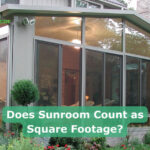As homeowners strive to expand their living spaces, the allure of connecting with the outdoors while maintaining shelter has led to the consideration of sunrooms and patio enclosures.
Both options offer unique advantages, but understanding their differences is crucial for making an informed decision aligned with your vision for enhanced living space.
Defining Sunrooms: Where Indoors Meets Outdoors
A sunroom is a dedicated space seamlessly integrated into a house’s existing structure, designed with expansive windows or panels to maximize exposure to natural light and scenic outdoor views. This emphasis on glass blurs the line between indoors and outdoors, creating a versatile space that can serve various purposes.
Sunrooms, often equipped with insulated glass, ensure year-round usability by regulating temperature and preventing heat loss during colder seasons. The pinnacle of sunroom design is the four-season variety, equipped with advanced heating and cooling systems for year-round comfort.
Understanding Patio Enclosures: Bridging the Gap
Patio enclosures, in contrast, are structures typically attached to an existing patio or deck, creating an enclosed outdoor space that shields from elements like wind, rain, and insects while fostering a connection with the outdoors.
Offering a compromise between indoor and outdoor living, patio enclosures combine solid walls for privacy and insulation with screened roofs and panels for ventilation and unobstructed views. This makes them an ideal choice for those desiring a semi-outdoor living experience.
Key Distinctions Between Sunrooms and Patio Enclosures
Construction and Integration With an Existing Patio
- Sunrooms seamlessly integrate with the existing house structure, featuring matching materials and architectural elements.
- Patio enclosures are often separate structures attached to an existing patio or deck, offering a degree of independence.
Purpose and Usability
- Sunrooms provide year-round usable living spaces conditioned for comfort, thanks to insulation, heating, and cooling systems.
- Patio enclosures, while offering shelter, are often considered seasonal due to reliance on screened panels, which may not provide sufficient insulation in colder months.
Views and Natural Light
- Sunrooms, with extensive glass panels, offer panoramic views and abundant natural light, creating a connection with the outdoor environment.
- Patio enclosures strike a balance between outdoor scenery and protection, though their views may be slightly more obstructed.
Cost Considerations
- Sunrooms are often pricier due to their higher level of construction, integration with the existing structure, and additional systems for year-round comfort.
- Patio enclosures, being standalone structures with fewer components, tend to present a more budget-friendly option.
Making an Informed Decision
In summary, while sunrooms and patio enclosures both offer a connection to the outdoors, they diverge significantly in terms of construction, purpose, views, natural light, and cost. Sunrooms provide a fully integrated, insulated outdoor space for year-round enjoyment, while patio enclosures offer seasonal shelter with a semi-outdoor experience. The choice between the two hinges on your specific needs, preferences, and budget.
By comprehending the distinctions between these structures, you empower yourself to make an informed decision that aligns with your vision for an enhanced living space. Whether you opt for the seamless integration of a sunroom or the versatile compromise of a patio enclosure, your choice will reflect your unique lifestyle and aspirations.



